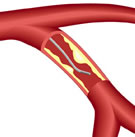| << To Blog Home >> | |
|
|
October 5, 2010 -- 7:10pm EDT Go With the Flow: Fractional Flow Reserve, That
Is Last November, the American Heart Association (AHA), American College of Cardiology (ACC) and the Society for Cardiac Angiography and Interventions (SCAI) updated their official guidelines, giving Fractional Flow Reserve (FFR) a Class "A" level of evidence. This past August, the European Society of Cardiology updated their official guidelines, boosting FFR to Class 1, level of evidence A -- the highest possible endorsement for this measurement modality. However, only about 15% of cath labs in the U.S. use this technology. So why aren't more using FFR, a functional measurement device which has been proven to reduce healthcare costs? As the FAME study showed, using FFR can cut the use of stents by one-third! Well, it has everything to do with reimbursement and the odd way in which that is applied in the U.S. For example, a cardiologist currently gets a small $99 Medicare payment (CPT® code 93571-26) for performing FFR; it's $78 for an additional vessel (CPT® code 93572-26). But the equipment and FFR catheter are not currently reimbursed to the hospital per se. They are allowable, but only under what's called a Diagnosis-Related Group (DRG): a lump "bucket" sum paid to the hospital for a PCI (a.k.a. an angioplasty or stent procedure). Most ancillary equipment used, such as FFR, has to be deducted from the fixed DRG payment -- so using this advanced and recommended technology to improve outcomes actually winds up costing the hospital money -- unless, of course, the hospital takes a wider view of costs and, as Dr. Pichard discusses, realizes the savings they've gained on the decrease in complications, repeat procedures and lower use of multiple stents. But taking that wider view takes convincing. Hopefully, the boost given to Fractional Flow Reserve (FFR) by the increased level of evidence in these international guidelines will be not only convincing but also reflected in a revisited and revised reimbursement policy for tools that improve PCI outcomes. |
|


 Yesterday
we posted our
Yesterday
we posted our